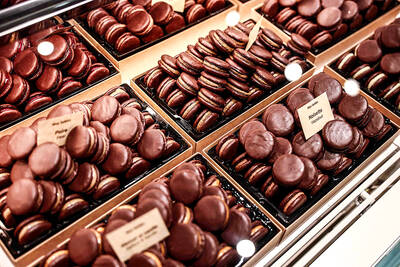S omewhere I Have Never Travelled (帶我去遠方), a film about the trials of growing up on the coast of southern Taiwan, is the debut feature of director Fu Tien-yu (傅天余), a protege of the prolific playwright and director Wu Nien-chen (吳念真). The movie possesses many of the strengths and weaknesses of Wu’s own work — a strong script combined with an excessively overt “Taiwanese” consciousness — but makes a solid effort to explore the experience of coming of age in small-town Taiwan, where the rest of the world seems hopelessly distant.
The film’s unspecified coastal town, which might be in the Kaohsiung area (where some of the location shooting took place), appears to be a desperately bleak place in which to spend one’s formative years. The ocean’s unforgiving horizon offers nothing but emptiness and oblivion to Ah-Hsien, a young man discovering his homosexuality, and Ah-Gui, a girl who suffers from color blindness, an affliction that is not recognized or understood by those around her. The duo’s travails constitute the bulk of the film’s story line, though Somewhere I Have Never Travelled manages to be a good deal more interesting than this bald synopsis suggests.
The specter of “social issues” floats just beneath the surface of the film, but is fortunately kept in check by the director’s overriding concern for her young non-professional actors as individual characters, not as vehicles through which to advance a social agenda. Ah-Hsien’s homosexuality and Ah-Gui’s color blindness seem just a trifle contrived and are ultimately superfluous, irrelevancies compared to the relentless isolation of their world.
Thankfully, Fu handles these issues in such a manner that they are not unduly intrusive, choosing to focus on the strong bond between the two siblings. The movie contains many genuinely charming character interactions, as well as numerous expressions of unfiltered intimacy, when the two young people take solace in their shared sense of being different from those around them.
These moments are the highlight of the movie, and the duo’s isolation is masterfully encapsulated by Fu’s use of the bleakly beautiful coastal scenery, which speaks volumes about the circumscribed world the two protagonists inhabit. Their struggle is juxtaposed with the experiences of the cast of adult characters, who have grown accustomed to this limited existence. The siblings’ father, an alcoholic street cleaner, still longs for the wife who left him years ago, and finds comfort in his collection of discarded shop store mannequins. Ah-Gui’s burning desire to escape seems almost sweet when compared to her father’s resigned acceptance of his fate. While Ah-Gui’s dreams are entirely unrealistic, she continues to dream. For the adults, however, dreams have long since died, buried in a graveyard of shattered hopes and aspirations.
This “serious” tone, handled largely by the non-professional cast, is balanced by the impressive cameos of professional entertainers such as Mei Fang (梅芳) and Lin Mei-shiu (林美秀), who provide the film with a welcome dose of humor, as well as some linguistic color. The movie’s more comedic sections are fun and, even if slightly contrived, work well in juxtaposition with the adolescent sullenness that characterizes much of the dialogue of the two leads.
While the film certainly does not lack charm, it is, at its core, a deeply sad film, though this poignancy is tarnished by Fu’s tendency to melodramatically fawn over her talented young cast. Luckily, Fu had the sense to make Somewhere I Have Never Travelled an ensemble piece: as such, the deficiencies of the young actors are never too glaring and their more experienced peers are always available for backup.

Many people noticed the flood of pro-China propaganda across a number of venues in recent weeks that looks like a coordinated assault on US Taiwan policy. It does look like an effort intended to influence the US before the meeting between US President Donald Trump and Chinese dictator Xi Jinping (習近平) over the weekend. Jennifer Kavanagh’s piece in the New York Times in September appears to be the opening strike of the current campaign. She followed up last week in the Lowy Interpreter, blaming the US for causing the PRC to escalate in the Philippines and Taiwan, saying that as

Nov. 3 to Nov. 9 In 1925, 18-year-old Huang Chin-chuan (黃金川) penned the following words: “When will the day of women’s equal rights arrive, so that my talents won’t drift away in the eastern stream?” These were the closing lines to her poem “Female Student” (女學生), which expressed her unwillingness to be confined to traditional female roles and her desire to study and explore the world. Born to a wealthy family on Nov. 5, 1907, Huang was able to study in Japan — a rare privilege for women in her time — and even made a name for herself in the

Would you eat lab-grown chocolate? I requested a sample from California Cultured, a Sacramento-based company. Its chocolate, not yet commercially available, is made with techniques that have previously been used to synthesize other bioactive products like certain plant-derived pharmaceuticals for commercial sale. A few days later, it arrives. The morsel, barely bigger than a coffee bean, is supposed to be the flavor equivalent of a 70 percent to 80 percent dark chocolate. I tear open its sealed packet and a chocolatey aroma escapes — so far, so good. I pop it in my mouth. Slightly waxy and distinctly bitter, it boasts those bright,

This year’s Miss Universe in Thailand has been marred by ugly drama, with allegations of an insult to a beauty queen’s intellect, a walkout by pageant contestants and a tearful tantrum by the host. More than 120 women from across the world have gathered in Thailand, vying to be crowned Miss Universe in a contest considered one of the “big four” of global beauty pageants. But the runup has been dominated by the off-stage antics of the coiffed contestants and their Thai hosts, escalating into a feminist firestorm drawing the attention of Mexico’s president. On Tuesday, Mexican delegate Fatima Bosch staged a